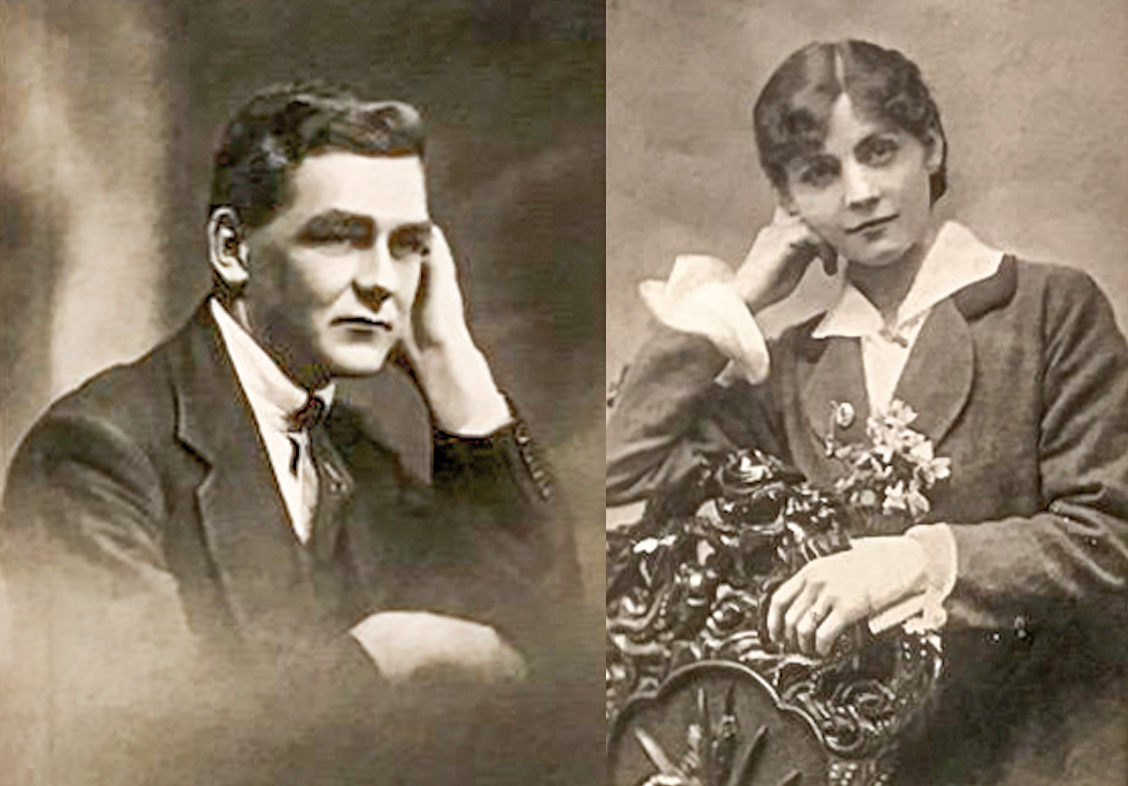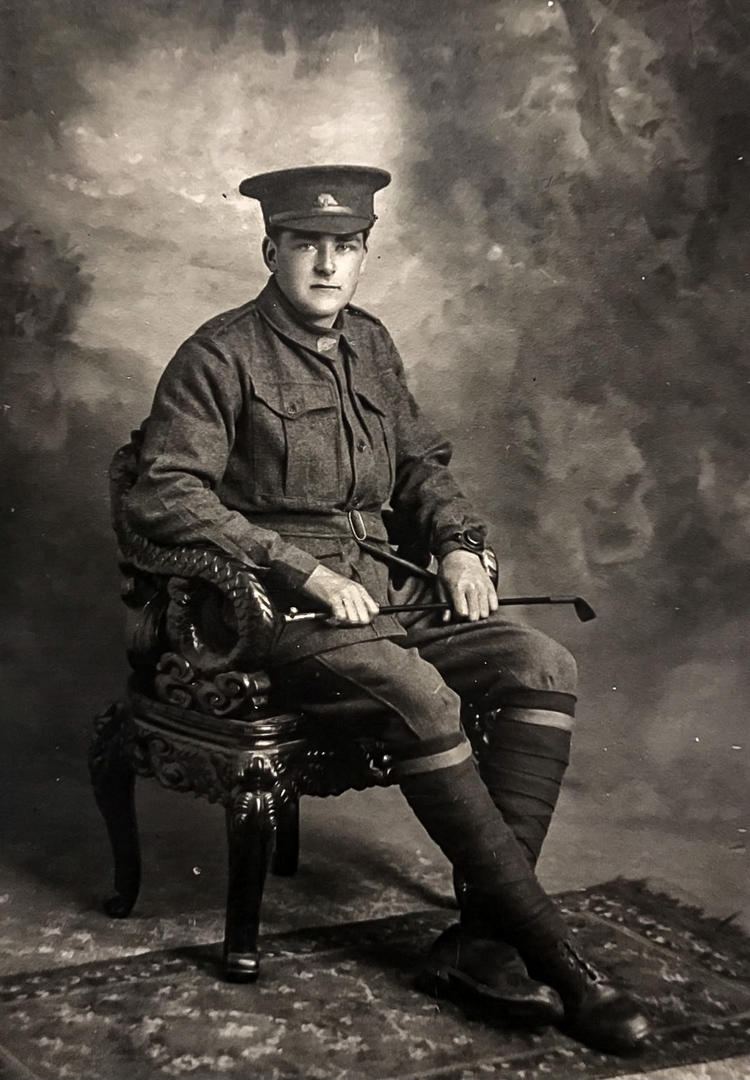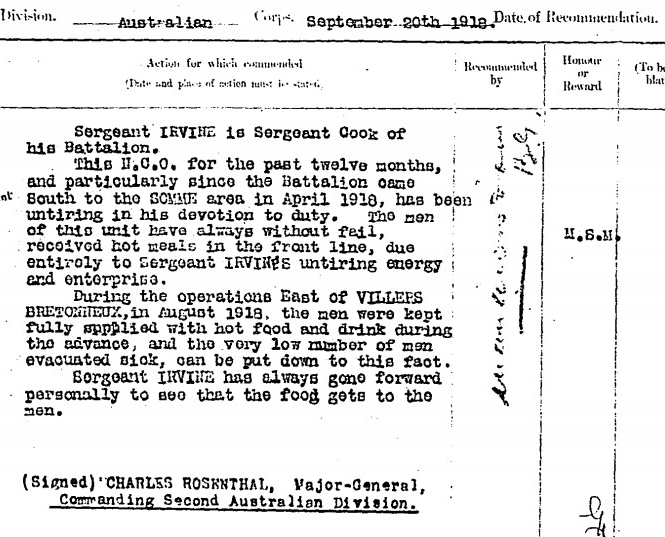Allan William James IRVING
Eyes blue, Hair brown, Complexion fair
Allan “Fatty” Irving
We thank Allan’s great nephew Dan Irving for sharing the family story.
Allan’s Early Life
When I first learnt about Allan there were two of his sisters still alive who both had vivid memories of him. Like many of us, I now regret not paying more attention when family history was being discussed. The sisters would refer to Fromelles as the Battle of Fleurbaix. Allan, known by the family as ‘Fatty’ and ‘Fats’, was in a family of seven children of William and Alice Maude Mary (nee Chamberlayne) Irving.
He was born on 28 April 1895 at the family home on Marion Street, Unley South Australia. Allan’s father William was born in Unley, SA, but his mother Alice had emigrated from Islington, England in 1883 when she was 13. His siblings were - Cecil Henry Arthur (Joe), Herbert Victor Clement, Victoria May, Lillian Sophia, Thomas Edward Lindsay and Alice Maude (Hazel).
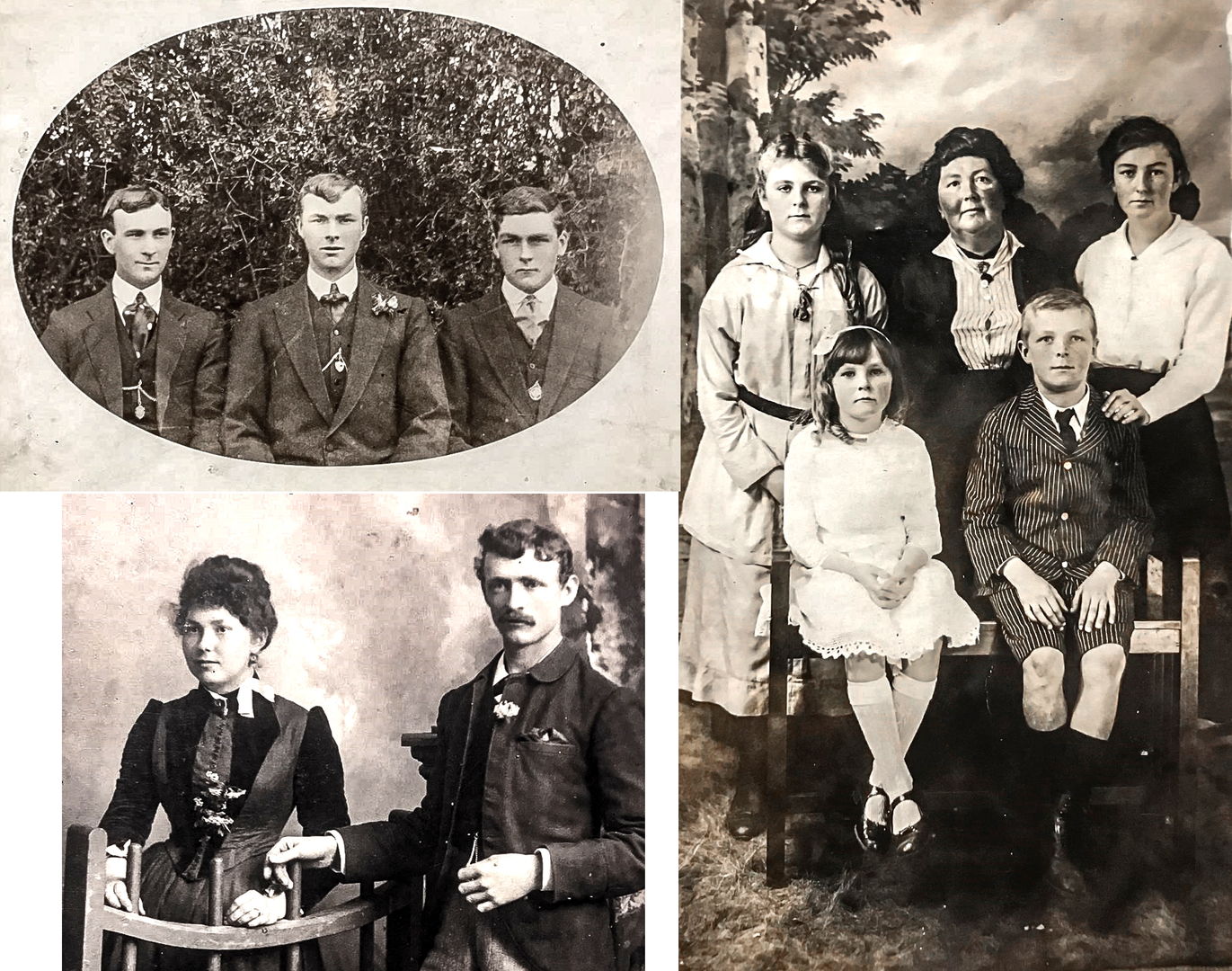
Top left - Joe, Bert and Allan; Top Right - Rear - Lilly, Alice (mum), May, Front - Hazel and Tom (c. 1917) Bottom left – Alice and William (c. 1890)
School records show Allan initially attended the Junior class at Unley Park School, however the family soon after relocated to the suburb of Hammersmith (Castle St., North Edwardstown). As a result, Allan attended Plympton Public School from 3 December 1900 and is recorded as leaving in mid-1908. After this, he was apprenticed to the bookbinding trade at the Government Printing Office. Allan's attestation states he had completed 8 years of a 9 year apprenticeship.

It isn't known for sure when Allan and Violet Rose Dicker became sweethearts, but they would have likely known each other from school. Violet's family had moved to Plympton from Towitta (approximately 100 km NE of Adelaide) in early 1908. Violet was enrolled at Plympton Public School from 12 Feb 1908. Regardless when it was, by the time Allan embarked the pair were engaged.
Off to War
With The Universal Training Scheme beginning in earnest in 1911, the 16 year old Allan began his exposure to the military. He served as a Senior Cadet with 'B' Company, 75th Battalion until July 1913 and then was transferred across to the Citizen Forces, ‘H' Company, 78th Battalion. He continued until enlisting in the AIF. Allan's older brother Bert (1534) was the first to enlist, 15 March 1915 and was assigned to the 27th battalion. He sailed from Australia on 31 May 1915.
Allan was also keen to enlist, but being under 21 years of age required the consent of his parents. Initially his mother wasn't willing to give it. Allan's youngest sister relayed the story of their mother saying she 'wasn't going to sign his death warrant', however she eventually relented and gave her consent.

On 9 July 1915, with both his mother's consent and letter of approval from his employers at the Printing Office in hand, Allan presented at Keswick Barracks to undertake a medical examination as well as complete his attestation forms. Finally, on 15 July 1915 Allan was enlisted into the AIF and marched into Mitcham Camp (the main training camp in SA) and was allotted to 'M' Group Base Infantry (basically a depot for men unallotted to any particular unit).
Allan didn't enlist alone, a number of Government Printing Office employees and friends also enlisted:
- 1517 Pte Frank Clifford Aitchison, known to be a mate of Allan. He survived the War.
- 44 Pte George Edward Bonney. He was killed at Fromelles. You can read George Bonney's story here.
- 21 Pte William Henry Ludemann. He survived the War
- 1531 Albert Henry Klaffer, a known cobber of Allan’s. Albert's sister Gertrude married Allan's eldest brother, Joe in 1919.
- Violet's twin brother also served - 4756 L/Cpl Frank Arthur Allen Dicker. He survived the War.
Being Government employees the difference in pay between their military and civil pay would be paid up to the time they left Australia, and upon return to Australia the balance would then be paid. A farewell social was held by the staff of the Printing Office on Friday 13 August at the Prince of Wales Hotel, Augas Street, Adelaide for a number of members of the Government Printing Office, who were soon to be leaving for the War. As a parting gift Allan was presented with a wristwatch and a clock. The 32nd Battalion was raised at Mitcham Camp on 9 August 1915 and Allan was allotted to the 1st Reinforcements.
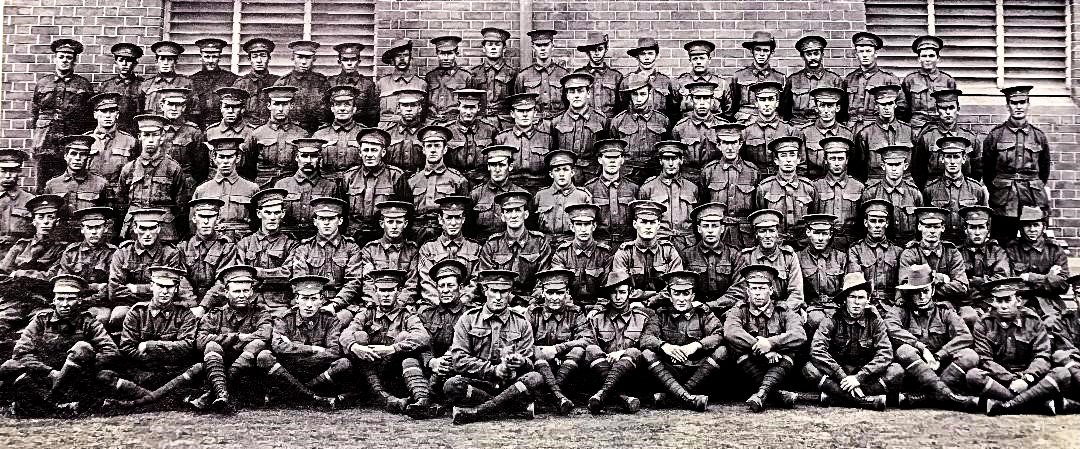
Allan is second row from back, 8th from right
In mid-September they relocated to the Cheltenham Camp (Cheltenham Park Racecourse).
The time spent in camp consisted of basic soldiering, organising and equipping in preparation for embarkation. In late September the South Australians were joined by approximately 500-550 men of 'C' and 'D' Companies of the 32nd Bn, which had been raised in WA. On the evening of 9 November 1915, the 32nd were entertained during a farewell send off by the Cheer-Up Society at their new Cheer-Up Hut (located on the site currently occupied by the Festival Theatre in Elder Park). The SA Premier was also in attendance. On the 18th November 1915, the time finally arrived for the 32nd to embark.
Commencing at 6.00am, batches of troops caught the train to Outer Harbour to board the troopship HMAT A2 Geelong. Thousands of friends and family were anxiously gathered on the wharf to farewell the troops, patriotic songs were sung, amongst the continual cheering, parting gifts and well wishes were exchanged. An hour prior to departure, coloured streamers were passed between the crowd and troops, who took to the ship's rigging for a better vantage point. Shortly after 11am the Geelong, attended by tugboats, moved off and slowly made its way down the channel and into the wider waters of the gulf.

As reported in The Adelaide Register:
“The 32nd Battalion went away with the determination to uphold the newborn prestige of Australian troops, and they were accorded a farewell which reflected the assurance of South Australians that that resolve would be realized.”
After an uneventful trip, Allan disembarked at Suez at 7.30am, 18 December and marched into the Moascar Camp. During this period the Battalion took up position on the Canal and continued its training and reorganisation. In February 1916 the 8th Brigade (29, 30, 31, 32 Bns) was allotted to the newly raised 5th Australian Division. Allan was taken on the strength of 'A' Coy, 32nd Battalion on 3 March 1916 at Tel-el-Kebir. While in Egypt, Allan was able to meet up with his brother Bert, who had returned from Gallipoli. The story goes that Bert wanted Allan to transfer to the 27th Bn so they could be together, but Allan wished to remain with his mates in the 32nd.
One soldier’s diary complained of their time in Egypt of being “sick up to the neck of heat and flies”, of the scarcity of water during their long marches through the sand and he described some of the food as “dog biscuits and bully beef”. He did go on to mention good times as well with swims, mail from home, visiting the local sights and the like. Source AWM C2081789 Diary of Theodor Milton PFLAUM 1915-16, page 29, page 12 You can read Theodor’s Soldier Story here
During their time in Egypt the 32nd had the honour of being inspected by H.R.H. Prince of Wales.
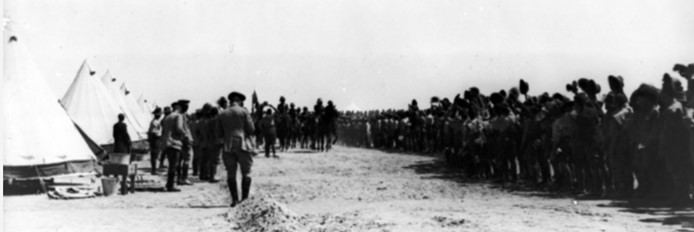
After spending six months in Egypt, the call to support the British Expeditionary Force on the Western Front came in mid-June. They left from Alexandria on the ship Transylvania on 17 June 1916 and arrived at Marseilles, France on 23 June 1916. They then had a two-day train trip to Steenbecque. Their route took them to a station just out of Paris, within sight of the Eiffel Tower, through Bologne and Calais, with a view of the Channel, before they disembarked and marched to their camp at Morbecque, about 30 kilometres from Fleurbaix.
Theodor Pflaum (No. 327) wrote about the trip in his diary:
“The people flocked out all along the line and cheered us as though we had the Kaiser as prisoner on board!!”
Fromelles

Training continued with a focus on bayonets and the use of gas masks, assuredly with a greater emphasis given their position near the front. On the 17th they were reconnoitering the trenches and cutting passages through the wires, preparing for an attack, but it was delayed due to the weather. D Company’s Lieutenant Sam Mills’ letters home were optimistic for the coming battle:
“We are not doing much work now, just enough to keep us fit—mostly route marching and helmet drill. We have our gas helmets and steel helmets, so we are prepared for anything. They are both very good, so a man is pretty safe.”
The overall plan was to use Brigades from the Australian Fifth Division to conduct a diversionary assault of the German trenches at Fromelles. The 32nd Battalion’s position was on the left flank, with only 100 metres of no man’s land to get the German trenches. As they advanced they were to link up with the 31st Battalion on their right. However, their position on the extreme left flank made their job more difficult, as not only did they have to protect themselves while advancing, but they also had to block off the Germans on their left, to stop them from coming around behind them.
On the morning of the 18th, Allan’s A Company and C Company went back into the trenches to relieve B and D Companies. B and D rejoined on the 19th. All were in position by 5.45 PM and the charge over the parapet began at 5.53 PM. Allan was among the first to go. They were successful in the initial assaults and by 6.30 PM were in control of the German’s 1st line system (map Trench B), which was described as:
“practically a ditch with from 1 to 2 feet of mud and slush at the bottom”.
Unfortunately, with the success of their attack, ‘friendly’ artillery fire caused a large number of casualties. They were able to take out a German machine gun in their early advances, but were being “seriously enfiladed” from their left flank.
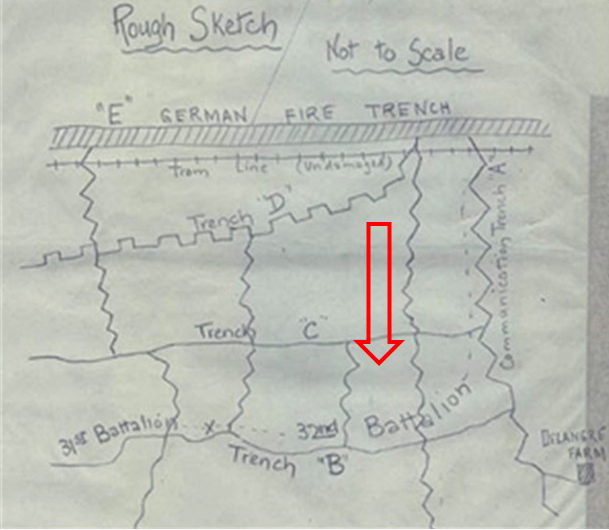
By 8.30 PM their left flank had come under heavy bombardment with high explosives and shrapnel. Return bombardment support was provided and the 32nd was told that “the trenches were to be held at all costs”.
Source AWM4 23/49/12, 32nd Battalion War Diaries, July 1916, page 12
Fighting continued through the night. Up ahead, the Australians made a further charge at the main German line beyond Trench B, but they were low on grenades, there was machine gun fire from behind and from the emplacement at Delangre Farm and they were so far advanced that they were getting shelled by both sides. In the early morning the Germans began an attack from the Australian’s left flank, bombing and advancing into Trench A (map).
Given the Australian advances that had been made earlier, the rear Trench E had been left almost empty, which then enabled the Germans to be in a position to surround the soldiers of the 32nd. Finding themselves surrounded and being fired upon from front, rear and flanks, the battalion was forced to charge back through the Germans (at their rear), across No Mans Land and to their original front-line trenches, being fired upon the entire way:
“The enemy swarmed in and the retirement across No Mans’ Land resembled shambles, the enemy artillery and machine guns doing deadly damage.”
What was left of the 32nd had withdrawn to their original front line by 4.10 AM and they were in the rear support trenches by 7.30 AM on the 20th. The initial roll call count was devastating – 71 killed, 375 wounded and 219 missing. To get some perspective of the battle, when Charles Bean, Australia’s official war historian, attended the battlefield two and half years later, he observed a large amount of bones, torn uniforms and Australian kit still on the battlefield. Lieutenant Sam Mills survived the battle. In his letters home, he recalls the bravery of the men:
“They came over the parapet like racehorses……… However, a man could ask nothing better, if he had to go, than to go in a charge like that, and they certainly did their job like heroes."
The final impact was that 225 soldiers of the 32nd Battalion were killed or died from wounds sustained at the battle and, of this, 166 were unidentified.
After the Battle
Allan was among the missing. Nothing was ever officially known of Allan's final moments, there are no witness statements to record any last sightings. Unsurprisingly, there was confusion surrounding Allan's disappearance. Initially he was reported as MIA, but then as being a POW-Unofficially (POW German List, 4 Nov 16), this was finally amended to KIA (German Death List, 4 Nov 16). The family remained hopeful and placed an ad in the Adelaide Chronicle in December 1916:
"A MISSING SOLDIER - Private Allan W. J. Irving.
No. 1528. Private Allan W. J. Irving (Fatty), A Company, 32nd Battalion, 8th Brigade, A.I.F., has been missing since July 20. Any news from soldiers or anyone will be gratefully accepted by his parents — Mrs. A. Irvine, Plympton P.O., Adelaide, South Australia."
Bert (and others) were also pursuing what else they could find out.

With reports from Germany in hand of Allan having been killed, Allan was formally declared as Killed in Action in June 1917. As late as April 1919, Allan’s mother Alice wrote to the Red Cross and she said that she'd been informed by two returned soldiers '... that Allan was left on the field wounded he was so heavy they could not carry him ...' Understandably she refused to accept that Allan had been killed, believing he may have lost his mind.
She eventually used his Army money to buy a property for him, at Kingston Park, in case he ever returned (Dan notes - following WW2 my grandparents would live in this house until their deaths). Violet also waited a number of years. She finally married in 1923.
Allan was awarded the 1914-15 Star Medal, the British War Medal, the Victory Medal, a Memorial Plaque and a Memorial Scroll. He is commemorated at:
- V.C. Corner (Panel No 5), Australian Cemetery, Fromelles
- Adelaide National War Memorial,
- Adelaide Treasurer and Chief Secretary Roll of Honour,
- Adelaide Treasurer and Chief Secretary Roll of Honour, Adelaide Treasurer and Chief Secretary WW1 Honour Board
- Australian War Memorial Roll of Honour
- Edwardstown District WW1 Roll of Honor
- Marion District Roll of Honour WW1
- and the Plympton District Roll of Honor.
###Found at Pheasant Wood After 94 Years
The family had always believed the Germans had likely buried Allan. The fact that his identity disc had been gathered by the Germans and later returned to the family meant his remains had been in their hands. Dan Irving had been in contact with Lambis Englezos for some time prior to the actual discovery, so it came as no real surprise to learn of Allan's positive identification in the initial group of men at Pheasant Wood in 2010.
As of 2024, 41 of the 166 missing soldiers from the 32nd Battalion have been identified and 180 of the total 250 soldiers in the grave. A number of family members provided DNA samples to the Fromelles Project including Dan’s uncle, the son of Allan's youngest brother (Dan’s grandfather). Two of Allan’s nieces attended the ceremony at Pheasant Wood. Dan added that, unfortunately, by then both of Allan’s sisters had passed and so there was no one who actually knew Allan alive to learn what had actually become of him.
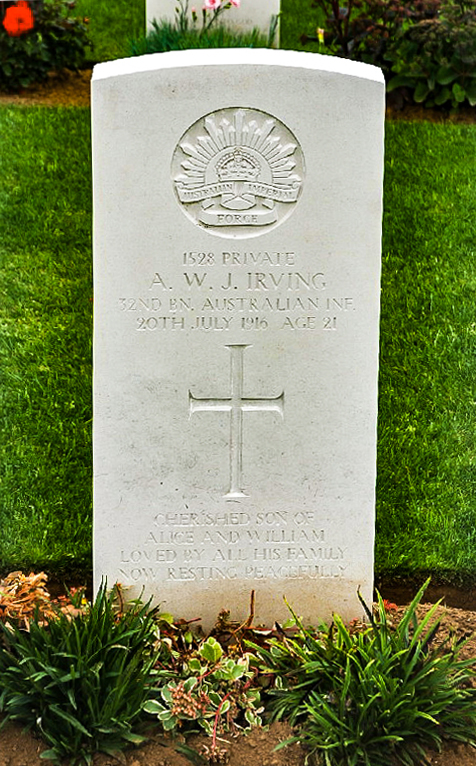
Loved by All his Family
Now Resting in Peace
###Brother Bert – Meritorious Service Medal
Allan’s brother Bert was the Sergeant Cook for the 27th Battalion and he survived the War. He was awarded the Meritorious Service Medal in June 1919 in recognition of his services during Villers Bretonneux in August 1918. As described in the award below the success in the battlefield can heavily rely on the health of the troops and Bert went above and beyond what was required.
The Fromelles Association would love to hear from you

Contacts
(Contact: carla@fromelles.info or geoffrey@fromelles.info).
(Contact: army.uwc@defence.gov.au or phone 1800 019 090).
Donations
If you are able, please contribute to the upkeep of this resource.
(Contact: bill@fromelles.info ).

